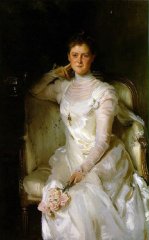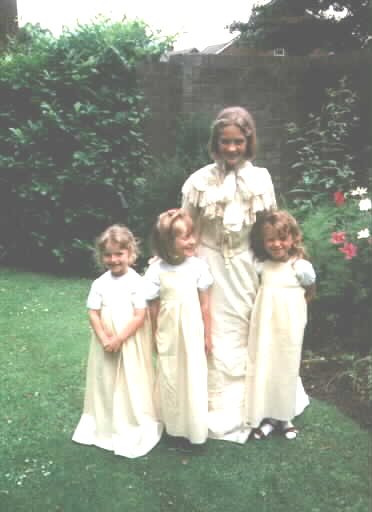The Wedding Day has arrived,
the most important event in a
Victorian girl's life. It is the
day
her mother has prepared her for
from the moment she was born.
The Victorian girl knew no
other ambition. She would marry,
and she would marry well.
Naming
the Day
The wedding
itself and the events
leading up
to the ceremony are
steeped in
ancient traditions still
evident in
Victorian customs.
One of the
first to influence a
young girl
is choosing the month
and day of
her wedding. June has
always been
the most popular month,
for it is
named after Juno,
Roman goddess
of marriage.
She would
bring prosperity and
happiness
to all who wed
in her month.
Practicality
played a part in this
logic also.
If married in June,
the bride
was likely to birth her
first child
in Spring, allowing her
enough time
to recover before
the fall
harvest.
June also signified the end of Lent
and the arrival of warmer weather.
That meant it was time to remove
winter clothing and partake in
one's
annual bath. April, November and
December were favored also, so
as
not to conflict with peak farm
work months. October was an
auspicious month, signifying a
bountiful harvest. May, however,
was considered unlucky. "Marry
in
May and rue the day," an old proverb
goes. But "Marry in September's
shine,
your living will be rich and fine."
In the Southern United Sates,
April was favored, as it was less
hot,
and a bride's favorite flowers
were in
bloom--jasmine and camellia.
Brides were just as
superstitious about days of the
week.
A popular rhyme goes:
Marry on Monday for health,
Tuesday for wealth,
Wednesday the best day of all,
Tuesday for crosses,
Friday for losses, and
Saturday for no luck at all.
The Sabbath day was
out of the question.
The Wedding
Ensemble
In the 16th and 17th
centuries
for example, girls in their teens
married
in pale green, a sign of fertility.
A mature girl in her twenties
wore a brown dress,
and older women even wore black.
From early Saxon times to the
th century, only poorer
brides
came to their wedding dressed
in white--a public statement that
she brought nothing with her
to the marriage.
Other brides wore their Sunday
best.
Color of the gown was thought
to influence one's future life.
White--chosen
right
Blue--love
will be true
Yellow--ashamed
of her fellow
Red--wish
herself dead
Black--wish
herself back
Grey--travel
far away
Pink--of
you he'll always think
Green-ashamed
to be seen
Ever since Queen Victoria wed in
1840,
however, white has remained the
traditional color for wedding gowns
and bouquets. A woman then used
her
dress for Court Presentation
after marriage,
usually with a different bodice.
The early Victorian wedding
dress had a fitted bodice,
small waist, and full skirt
(over hoops and petticoats.)
It was made of organdy, tulle,
lace, gauze, silk, linen or cashmere.
The veil was a fine gauze, sheer
cotton or lace. The reasonable
cost
of a wedding gown in 1850 was $500,
according to Godey's,
with $125 for a veil.
By 1861,
more elaborate gowns cost as
much as $1500
if constructed with lace.
Formal weddings during this period
were all white,
including the bridesmaid's
dresses and veils.
Veils were attached to
a coronet of flowers,
usually orange blossoms
for the bride and roses or
other in-season flowers
for the attendants.
The bride's accessories included:
short white kid gloves,
hanky embroidered
with her maiden name initials,
silk stockings embroidered up the
front, and flat shoes decorated
with bows or ribbons at the instep.
The American Frontier bride
of the 1850s and 60s usually
chose cambric, wool or linen
dresses in a variety of colors.
Few wore white, as the dress
was used later for special events
and church. Many had a warm,
colorful shawl in paisley or plaid
which draped her shoulders at the
wedding. The shawl was then used
for christenings, social events
and an
extra blanket in winter. A warm
shawl
was more cherished than
a wedding dress.
For the mid-Victorian bride
(1870s) there was an emergence
of middle class wealth,
and with it a display of
their new riches. Wedding gowns
fashioned by Worth in Paris were
the
ultimate status symbol.
And if one couldn't afford
an original, one copied them.
Full court trains were now part
of the
wedding ensemble, as were long
veils,
a bustle, elegant details
and two bodices
--a modest one for the wedding
and a low one for special occasions.
The late Victorians (1890s)
saw the bustle disappear,
a demi-train and large
sleeves now in fashion.
If the bride married in church,
the dress must have a train,
with a veil of the same length.
The veil could be lace or silk
tulle.
From the mid-Victorian era
to the 1890s, the veil covered
the bride's face and was not
lifted until after church.
The veil was not used as a shawl
after the wedding any more, however.
White kid gloves were long
enough to tuck under the sleeves,
and had a slit in one finger
to slip the ring on
without removing the glove.
Slippers were of white kid,
satin or brocade and
the heels rose to one inch.
For the widow
who remarried in the early
and mid-Victorian eras,
she did not wear white,
had no bridesmaids, no veil
and no orange blossoms,
(a sign of purity.)
She usually wore a pearl or lavender
satin gown trimmed
with ostrich feathers.
In the later decades, she was allowed
attendants as well as pages,
but no veil or orange blossoms.
She could wear a shade or
two away from white,
preferring rose, salmon,
ivory or violet.
As for jewelry, diamonds have
always been popular. When white
dresses were in vogue, pearl and
diamond combinations
were fashionable.
The mid-Victorians had a more
extravagant display of wealth,
often a diamond tiara
for the ceremony.
Combination pieces of diamond
jewelry that could be
separated later as individual
pieces were popular.
Traditionally,
the jewelry worn by the bride
was a gift from her husband.
The earlier in the day
the wedding, the less jewelry.
Finally, for the bride,
you may recall the English rhyme:
"Something old,
something new,
something borrowed,
something blue,
and a lucky sixpence
in your shoe."
Something old was often
a family heirloom and
the bride's link with the past.
Something new could be
her dress or a gift from the groom.
Something borrowed was of real
value
like a veil or headpiece,
and returned to the owner.
Something blue was often the garter
or an embroidered handkerchief.
The touch of blue
symbolized faithfulness,
while the sixpence
ensured future wealth.
A Groom's
Attire
The grooms,
too,
were concerned
with fashion
on their
wedding day,
and turned
to magazines for
advice on
how best to be
turned out.
In the early
Victorian
era, the bridegroom
wore a frock
coat of blue,
mulberry
or claret,
and a flower
favor in his lapel.
By 1865,
men's coats were tailored
with a special
"flower-hole"
for this
purpose.
His waistcoat
was white,
and his trousers
of
lavender
doeskin.
Black was
out of the question.
The best
man and groomsmen
wore frock
coats also,
but in a
more subdued tone.
The American
frontier groom
wore a flower
on the lapel of
his best
suit, using whatever
was in the
bride's bouquet.
By the mid-Victorian era,
frock coats were seldom worn,
the morning coat being preferable
because of its smarter appearance.
Some grooms still wore frock coats,
however, and did so with a vest
of black cloth, dark gray trousers,
a folded cravat of medium color,
and lavender gloves stitched in
black.
Fashions changed rapidly in the
late Victorian years, from no need
for gloves in 1885, to a must for
gloves in 1886. By now, however,
men wore pearl colored gloves
with black embroidery. By 1899,
the frock coat was back in style
along with a double-breasted,
light-colored waistcoat, dark tie,
gray striped cashmere trousers,
patent-leather button boots and
pale tan kid gloves. Throughout
the Victorian era, a black top
hat was a necessity.
By the end of the Victorian era,
boutonnieres were large--
a bunch of lilies,
a gardenia or stephanotis sprig.
If the wedding was in the evening,
as now allowed by English law,
full dress tailcoats were in order,
with white gloves and white waistcoat.
The father of the bride dressed
like the
groom and groomsmen, and according
to the time of day for the wedding.
Gowns for
the bridesmaids
had to be
both practical and
beautiful,
for they became a
part of the
girl's wardrobe
after the
ceremony. Some
generous
brides provided
the dresses
for their attendants.
During the
early Victorian years,
skirts were
full and bodices tiny.
Tradition
called for an all white
wedding,
but color could be added
for an accent
if the overall effect
remained
white. Bridesmaids
covered their
heads with short white
veils falling
from a coronet to just
below the
hip. Weddings at
home did
not require a veil, and
often headpieces
of flowers
and ribbons
were worn.
By the mid-Victorian era,
bustles were the height of fashion.
White was no longer the color,
but was still worn at some weddings,
often in combination
with another color.
By the 1890s,
the Victorians were more willing
to try innovative new fashions,
closely following fashions from
Paris.
Large sleeves were in style,
emphasizing the shoulders.
Grey, violet and lilac were
popular in England,
while Americans preferred white,
rose or green. By 1898,
fashion dictated that the bridesmaids'
dresses be in direct contrast
to the bride's,
so as not to distract
from the beauty of her gown.
That custom is still in practice
today.
Children were a symbolic part of
the Victorian wedding and
had their own dress etiquette.
Little girls could be flower
girls or ring bearers. If older,
they could be junior bridesmaids
or
maids of honor.
Regardless of their role,
their dresses were of white muslin
tied with a ribbon sash
that matched their
shoes and stockings.
The dresses were either long or
short
depending upon the prevailing
styles and ages of the girls.
The boys had the important role
of holding the bride's train.
They dressed as court pages
in velvet jackets,
short trousers and round
linen collars fastened by
large bows of white crepe
de chine or surah.
Their laced shoes were black,
unless it was a formal wedding,
in which case they
wore white silk hose,
and buckles on their shoes.
Their velvet suits could
be black, blue, green or red,
with a matching hat,
which was optional.
The hat was removed
for a church ceremony.
Social customs dictated what the
mothers and female guests wore,
also, the difference subtle
yet present.
At a daytime wedding,
guests wore walking or
visiting costumes.
The mothers, and other
female family members,
wore reception toilettes,
being more elegant
than daytime costumes,
but less formal than
evening dress.
All women had to wear
bonnets in church,
but they were optional
for at-home ceremonies.
Bonnets were not worn
for evening receptions.
In the late Victorian era,
black was suggested as
an appropriate color
for the mother of the bride.
These were never made
of black crepe, however,
which signified mourning.
If the mother was in mourning,
she could put aside her crepe
for the ceremony and wear
purple velvet or silk
in America,
or cardinal red in England.
Queen Victoria, the mother
figure at many weddings,
always wore black and
white because she
was in mourning
for her "dearest Albert."
Everyone is finally
primped and curled.
It is time for the ceremony to
begin!
THE CEREMONY
& RECEPTION

